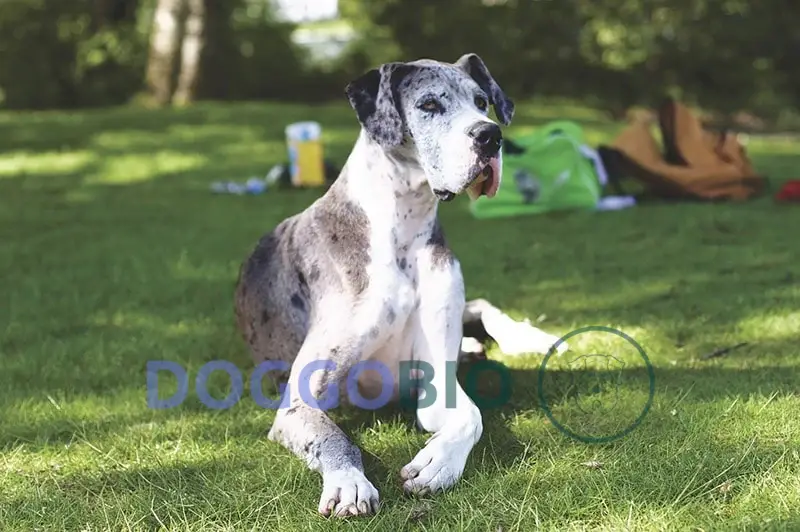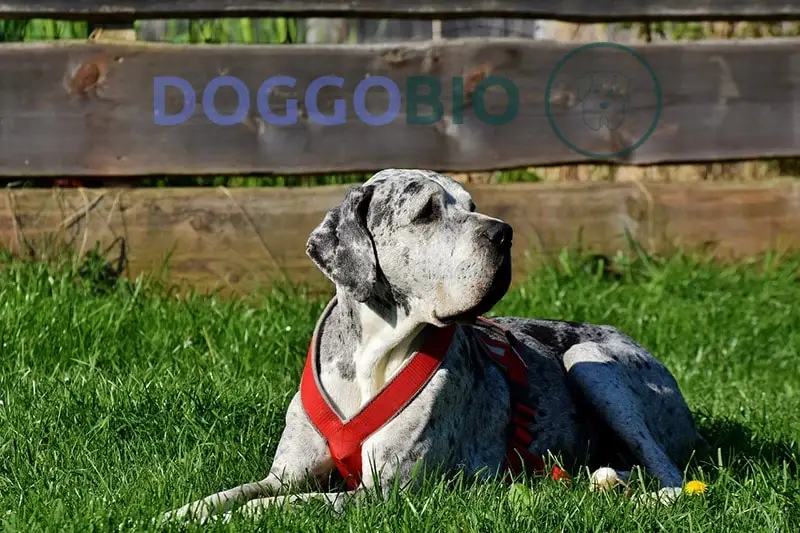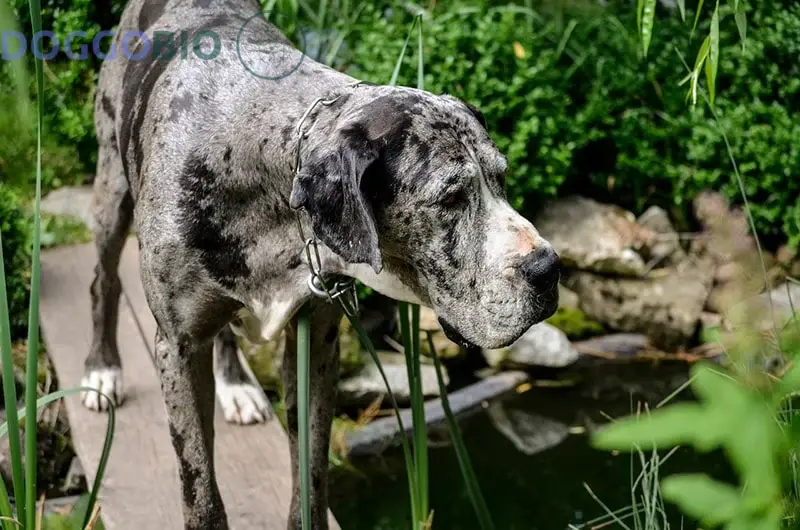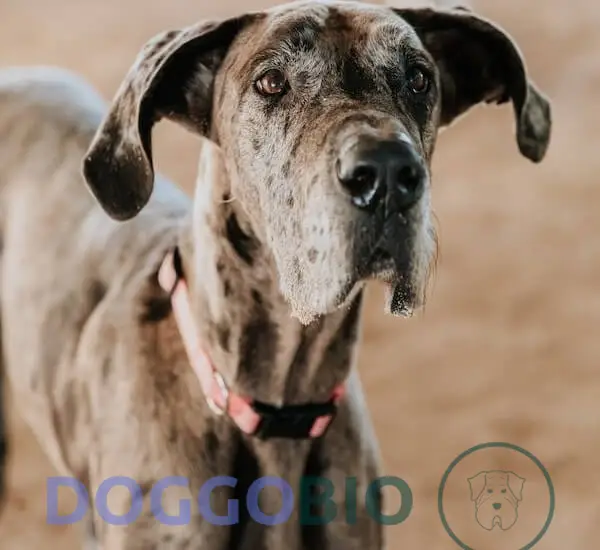In the realm of canine grandeur, the Merle Great Dane reigns supreme with its regal appearance and imposing stature. Originating from the distinguished lineage of the Great Dane, this breed boasts a striking coat pattern of splotches and speckles, adding a captivating twist to its majestic presence.
In this article, we will explore the allure of the Merle Great Dane, uncovering its unique qualities, gentle temperament, and historical significance as a loyal companion and guardian. Join us on a journey to discover the enchanting world of the Merle Great Dane—a genuinely remarkable canine marvel that captivates the hearts of dog enthusiasts worldwide.
A Brief Overview of Merle Great Dane
| Other Names | Merle Dane, Merle Great Dane dog |
| Purity | Purebred |
| Purpose | Hunting |
| Size | Giant |
| Height Range | 28-32 inches |
| Weight Range | 110-175 pounds |
| Coat Colors | Blue, harlequin, fawn, orange, chocolate, brindle, silver, gray, platinum, red, brown, tricolor |
| Child Friendliness | High |
| Canine Friendliness | Moderate |
| Training Difficulty | Low |
| Grooming Upkeep | Low |
| Exercise Needs | Low |
| Health Concerns | Moderate |
| Lifespan | 7-10 years |
| Average Puppy Cost | $700-$4,000 |
What is a Merle Great Dane?

Discover the captivating world of Merle Great Danes! They come in various colors and have a unique, lighter coat adorned with dark grey spots.
This striking coat pattern is not limited to Great Danes but can also be found in other breeds like Australian Shepherds and Shetland Sheepdogs.
Confused with Harlequin Danes sometimes, Merles have a distinguished grey base coat and are often produced from Harlequin litters.
What is a Double Merle Great Dane?
A double Merle Great Dane puppy receives two copies of the Merle gene, one from each parent.
Unfortunately, these pups are at a higher risk of health issues, so breeding two Merle Danes together is not recommended. Responsible breeders avoid such pairings to prioritize the well-being of the dogs and promote healthier litters.
How To Get a Merle Great Dane?
They are often produced by breeding Harlequin Great Danes, with the critical genetic difference being the gene responsible for their grey coloring.
Breeding two Harlequins typically results in litters with one or two Merle puppies, while breeding a Harlequin and a Mantle Great Dane can produce Merles. These striking dogs depend on the presence of the merle gene, responsible for their captivating grey base coat.
However, if a puppy inherits two merle genes, it will likely be a White Dane, a rarer variation. Breeding two dogs with the Merle gene can lead to health problems, but attempts to eliminate the Merle coloring have been unsuccessful, and we still have Merle Great Danes today.
Is it ethical to breed Merle Great Dane?
No, breeding Merle Great Danes is generally considered unethical due to significant health risks. The Great Dane Club of America advises against the intentional breeding of Merles.
Breeding them can lead to stillborn or sick puppies and increased chances of blindness, deafness, and other health problems, particularly in White Great Danes born from two Merle parents. While not all White Great Danes suffer from these issues, testing for potential health problems is crucial.
Breeding Merle Great Danes may also contribute to aggressive behavior, skin disorders, and brain abnormalities, though more research is needed to confirm these links.
Owners of this breed are encouraged to neuter or spay them to prevent these risks. DNA tests for the merle gene are available but require careful consideration.
History of Merle Great Dane
The Merle Great Dane’s history dates back to ancient times, with depictions in Egypt, but it’s primarily traced to Germany and England.
These dogs emerged from crossing Greyhounds and English Mastiffs, possibly with Irish Wolfhound influence, to create a breed adept at hunting wild boars. The resulting Great Dane was large, strong, and fast.
Among its seven coat variations, the Merle pattern was present from early on. In the late 1800s, they were introduced to the United States, solidifying their notable status in the canine world.
Interesting Facts about Merle Great Dane

1. It Just Needs One Parent to Have the Merle Gene
Having a Merle Great Dane is sufficient for just one of their parents to possess the Merle gene. You can even have Merle puppies without both parents being merles.
2. In the Past, Breeders Tried to Eliminate the Merle
In the past, breeders and veterinarians mistakenly attributed many health problems in Great Danes to the Merle coloring. Due to this misunderstanding, efforts were made to eliminate the merle color from the breed.
However, once it was discovered that most health issues stemmed from double merles, not the merle gene itself, breeders halted their attempts to eradicate the merle coloring.
3. They Aren’t Rare
Contrary to what some unethical breeders may claim, the Merle coat color is far from rare among Great Danes.
It is relatively common and straightforward to breed. If a breeder attempts to persuade you otherwise, seeking another reputable breeder is essential.
4. They have various coloring patterns
The charm of Merle Great Danes lies in their various coloring patterns, making each one truly special. These unique types are solid merle, blue merle, chocolate merle, brindle merle, and mantle merle.
To unveil the specific pattern of your Great Dane, it’s best to wait as long as possible before adoption, as their puppy coat may differ from their adult coat. Embrace the delightful surprise as your canine’s true colors are unveiled!
5. Breeding two Merle Great Danes
Breeding two Merle Great Danes, though seemingly effective for producing more Merle puppies, is highly discouraged due to serious health risks.
“Double Merle” offspring commonly face severe issues like deafness and blindness, with a near-certain chance of being born blind. Additionally, double Merles can inherit and propagate these health problems in their lineage.
Responsible breeders avoid such pairings to prioritize the dogs’ health and ensure robust, healthy litters.
6. Ear cropping in Great Danes
The practice of ear cropping in Great Danes traces back to the early days of their breeding. It emerged shortly after the first Great Danes were developed.
During that time, these magnificent dogs fought wild boars with razor-sharp tusks. To protect them from these fierce encounters, ear cropping became a common practice, still prevalent among Great Dane owners today.
7. They were initially bred to hunt wild boars
As previously mentioned, Great Danes were originally bred to hunt wild boars, which required them to possess a fierce and vicious nature to match the wild boar’s aggression in battle.
However, times have changed, and today’s average Merle Dane is a loving and affectionate pet rather than a fighter. The breed has evolved into gentle and devoted companions, leaving behind their historical role as aggressive hunters.
8. They are sensitive to the sun’s UV rays
A notable trait among Merle Great Danes is their sensitivity to the sun’s UV rays, leading to a higher risk of skin cancer. Due to this susceptibility, keeping your dog indoors is advisable to protect their health and well-being. This precautionary measure can help ensure your beloved pet’s happy and healthy life.
What does a merle Great Dane look like?
The Merle Great Dane is distinguished by its unique coat pattern while maintaining the breed’s typical large, athletic build and long limbs. Its short, smooth coat features a distinctive mottled pattern.
These dogs often have captivating eyes in shades of blue, green, or brown, and some may even display heterochromia with one blue and one brown eye.
The breed is also known for commonly having cropped ears, giving them an upright appearance rather than the natural floppy style.

Size, height, and Weight
The Merle Great Dane stands out as a dog giant. Among the Merle Great Danes, the males are usually taller, heavier, and more robust than the females.
| Dog Breed | Average Height | Average Weight |
| Male | 30-32 inches | 140-175 pounds |
| Female | 28-30 inches | 110-140 pounds |
Temperament and Personality
Merle Great Danes are known for their gentle and affectionate temperament, earning them the nickname “Gentle Giant.” They are excellent family pets, displaying a caring nature towards children. However, due to their large size, supervision is recommended around small children to prevent accidental knocks.
These Danes usually coexist peacefully with other pets, especially when introduced at a young age. With proper socialization, a Merle Dane can be a loving and cherished addition to any family.
Training and Exercise Requirements
Training a Merle Great Dane is surprisingly more accessible than other large breeds. They are intelligent and quick learners, making them brilliant companions for learning commands and tricks. However, early socialization and obedience training are crucial to ensure they don’t become overly protective or aggressive.
While the Merle Great Dane isn’t overly active, they still require regular exercise to maintain their health and happiness. A daily one to two-hour walk or a light play session should suffice. Avoid overexertion, as it may strain their large bodies and lead to joint problems in the future.
Given their size, Merle Great Danes need plenty of space to move around and be better suited for apartment living. A large, fenced-in yard allows them to run and play without bumping into things or knocking them over.
Grooming and Cleaning
Grooming a Merle Great Dane requires attention to keep their coat and overall hygiene in good shape. While they have short and single skin, they shed moderately throughout the year, with heavier shedding in the spring.
| Grooming Task | Frequency |
| Hair Brushing | Weekly |
| Bathing | Every 6 weeks |
| Ear Cleaning | Weekly |
| Tooth Cleaning | 2-3 times per week |
| Haircutting | Not needed |
| Nail Trimming | Monthly |
Food and Diet
As a large breed, the Merle Great Dane requires a specialized diet to sustain its energy levels. Providing premium quality dog food or plain boiled meat is essential to meet their nutritional needs.
To ensure your Merle Dane gets the appropriate amount of food based on age, W\weight, and activity level, consult your veterinarian. They can guide you on the proper feeding portions for your pooch.
Life Expectancy and Common Health Issues
Regarding health concerns, Merle Great Danes face similar risks to larger breeds. Like any Great Dane, they are susceptible to various health issues, such as:

- Heart disease,
- Cancer,
- Foot and pad problems,
- Wobbler’s Syndrome,
- Hip dysplasia,
- And hypothyroidism.
These are common ailments found in larger dog breeds, and Merle Great Danes are no exception.
However, the specific health issues in Merle Great Danes are related to breeding two dogs carrying the Merle gene. In such cases, the resulting litter may be prone to experiencing blindness and deafness, two prevalent health conditions observed in Merle Great Danes. These issues are also commonly seen in White Great Danes and other breeds like Collies and Aussies.
Despite these potential health challenges, Merle Great Danes can lead happy and fulfilling lives with proper care and attention. Regular veterinary check-ups and responsible breeding practices can contribute to their overall well-being and ensure they have the best chance for a healthy life.
How Much is a Merle Great Dane?
Depending on the breeder, the health clearances of the parents, and the coat color, you can expect to pay anywhere from $700 to $4,000. If you prefer adoption, the fee for a Merle Dane will generally be lower than purchasing a puppy.
Is this breed The Right Dog for me?
The Merle Great Dane is excellent for families seeking a big, affectionate, and amiable companion. However, families with young children, small pets, or limited living space may not fit this breed best.
List of dogs that are similar to Merle Great Dane
Frequently Asked Questions
Does AKC recognize Merle Great Dane?
Yes, Merle Great Danes can indeed be AKC-registered. According to the AKC’s guidelines, Merle Great Dane puppies are eligible for registration.
In 2019, the American Kennel Club (AKC) officially recognized the Merle coat color variation, granting Merle Great Danes the privilege of AKC registration. If you have a purebred Merle Great Dane, you can register them with the AKC and participate in their events and competitions, just like other recognized coat colors.
Are Merle Great Danes Rare?
No, Merle Great Danes are not particularly rare. While some breeders may price them higher due to their unique coloring, at least one Merle puppy is often found in a litter. The perceived rarity may increase due to confusion between Merles and Harlequins, depending on the color variation.
However, certain Merle colorings, like those with blue or tan/brown hues, might be less common compared to the standard grey, white, and black markings.
Are Merle Great Dane hypoallergenic?
No, the Merle Great Dane is not hypoallergenic.
They do shed their coat, although not excessively like some other breeds. To reduce the amount of loose fur, it’s recommended to brush your Merle Dane daily, especially during the heavy shedding season.
What is a Blue Merle Great Dane?
A Blue Merle Great Dane is a stunning canine characterized by its blue and silver coat.
These majestic dogs typically have a lighter base color adorned with darker patches, producing an exquisite marble effect. The Blue Merle Great Dane’s unique coat pattern adds to its charm and allure, making it a beloved and captivating breed among dog enthusiasts.
Conclusion
In conclusion, the Merle Great Dane exemplifies the perfect blend of beauty, grace, and gentleness. With its regal appearance and captivating coat pattern, this majestic breed has rightfully earned its place as a beloved companion worldwide.
Whether as a loyal guardian or a cherished family member, the Merle Great Dane continues to leave an indelible mark on the hearts of all who encounter its enchanting presence.

Pingback: Great Dane Husky Mixes: Personality and Characteristics 2024